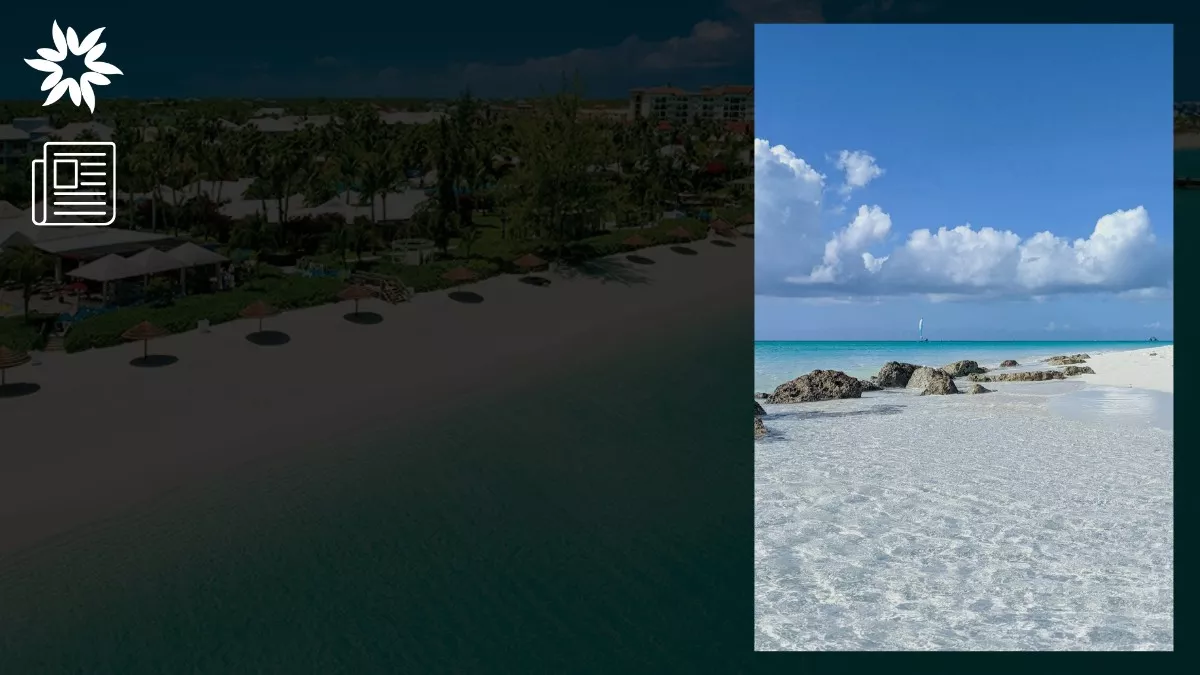
Without question, the Caribbean is a dream destination.
With over 700 islands, cays, and reefs, there’s a spot for everyone—whether you’re after a fancy beach escape in Turks & Caicos, a reggae-filled adventure in Jamaica, or a romantic sunset in St. Lucia.
The weather stays warm all year, averaging between 75°F and 85°F, which means you can swap your winter coat for a swimsuit anytime.
And you might be wondering when the best time to visit is.
Well, in all honesty, it depends on your style—December to April is the busiest, with perfect weather but higher prices, while May to November is for the deal hunters who don’t mind a little rain (or the rare hurricane).
Now, let’s get started and break down the best Caribbean destinations for 2025, what to do, what to eat, and more!
The Turks & Caicos Islands are known for their white-sand beaches, stunning coral reefs, and ultra-luxurious resorts. And I’d go so far as to say it’s the most beautiful Caribbean island, so it had to take first place in this guide.
With 100 islands and cays, only nine are inhabited, so it’s the perfect escape for travelers seeking relaxation away from crowds.
The most popular island, Providenciales (Provo), is home to Grace Bay Beach, which is consistently ranked among the world’s top beaches.
The beach’s soft, powdery sand and crystal-clear turquoise waters make it a dream destination.
But, say you’re looking for history and culture, Grand Turk is somewhere you’re likely to fall in love with—it was where John Glenn’s Friendship 7 space capsule landed after orbiting the Earth.
Salt Cay is another gem, and it’s famous for its diving sites and whale-watching opportunities.
The best time to visit Turks & Caicos is between April and May when hotel prices are lower and the crowds from peak season (December to March) have thinned.
However, booking a year in advance can save you money if you want to visit in the winter months.
In terms of currency, the islands use the U.S. dollar, which is handy as you don’t have to fork out ATM withdrawal fees if you take out cash before leaving the states.
Just keep in mind that smaller islands have limited ATMs, so having cash on hand is advisable.
If you didn’t know already, the Caribbean is home to some of the best food in the world. So, while you’re here, it would be a crime not to indulge in crispy conch fritters, steamed Caribbean lobster, and rice and peas.
Sure, dining can be expensive if you’re eating Western food, but local eateries and mom-and-pop restaurants offer delicious meals at a fraction of the cost of high-end resort dining.
Although safety is generally not a concern, travelers should avoid leaving valuables unattended on beaches. It’s like anywhere: with some knowledge of the culture and common sense, you’ll be just fine.
On top of all this, the islands have some of the best coral reefs in the world, so it’s a renowned destination for scuba divers and snorkelers.
St. Lucia is often considered the best honeymoon destination in the Caribbean, but this island is far from being only for couples.
It’s textbook paradise; you’ll find sublime rainforests, volcanic beaches, and more day adventures than you’d expect.
You can check out the island’s most iconic landmark, The Pitons, which is a UNESCO World Heritage site.
There are twin volcanic spires that rise dramatically from the sea, making them a prime spot for hiking.
But for something more chill, visit the Sulphur Springs & Mud Baths in Soufrière, where you can bathe in warm volcanic mud that’s said to have healing properties.
And if you’re visiting in early May, there’s the St. Lucia Jazz & Arts Festival, held at Pigeon Island National Landmark.
The best time to visit St. Lucia is from May to June, as this is when the crowds drastically die down.
Oh, and electricity in St. Lucia runs from 220 to 240 volts, so if you’re coming from the U.S., you may need an adapter.
The official currency is the Eastern Caribbean Dollar (XCD), but the U.S. dollar is widely accepted.
Driving is done on the left side of the road, which may take some getting used to if you’re renting a car.
As for the food, saltfish and green bananas are the national dishes, dating back to the time when salted cod was a staple for sailors.
Other must-try dishes include barbecued pork, chicken, and cocoa tea from local cocoa, spices, and milk.
Safety in St. Lucia is generally good, but travelers should avoid walking alone at night in less populated areas and be mindful of mosquitoes during the wet season.
The British Virgin Islands (BVI) offer some of the most exclusive and secluded travel experiences in the Caribbean.
Its 50-plus islands and cays are famous for their pristine beaches, luxurious villas, and world-class sailing.
One of the top spots in the BVI is Virgin Gorda, home to The Baths, a unique beach filled with granite boulders that create natural pools and caves.
Perhaps you’re coming here for a remote escape. Anegada is perfect for this, known for its slow pace, flat landscape, and stunning white-sand beaches.
The best time to visit BVI is from September to November, right before the winter holiday crowds arrive.
Hotel rates are lowest during this time, but hurricane season runs from June to November, so be sure to check the weather forecast.
The official currency is the U.S. dollar, but bring cash for smaller islands where credit cards may not be accepted.
Of course, you have to give the local food a crack, and fish and fungi, the national dish, which consists of okra, cornmeal, and braised fish, is a meal you didn’t know you needed in your life.
The islands are also famous for the Painkiller cocktail, which is made with pineapple juice, orange juice, cream of coconut, and rum.
And thankfully, crime here is rare, but island roads can be challenging to navigate, so renting a car is not recommended.
The best way to get around is by boat, ferry, or taxi.
The Cayman Islands are fitting for families, divers, and luxury travelers.
This group of three islands—Grand Cayman, Cayman Brac, and Little Cayman—offers everything from beachfront relaxation to world-renowned dive sites.
The best place to start is Seven Mile Beach on Grand Cayman, famous for its soft sand and clear waters.
But if you want to push the boat out a little, visit Stingray City, where visitors can swim alongside friendly stingrays in shallow waters.
And if you love hiking, take a trek on the Mastic Trail, a scenic nature path through the island’s tropical forest.
The best time to visit the Cayman Islands is between March and June, when hotel rates drop, and the weather is still pleasant.
The official currency is the Cayman Islands Dollar (CI$), but U.S. dollars are widely accepted.
Restaurants and taxis expect a 10-15% tip, so check your bill to see if gratuity is already included.
Alongside being some of the most beautiful Caribbean islands, the food is some of the best, too, so dabble in some conch stew, jerk chicken, and fresh seafood.
If you’re vegetarian, though, visit VIVO, a popular restaurant offering organic, gluten-free, and plant-based dishes.
Crime is minimal, but heat and sun exposure are real concerns.
Always wear sunscreen, drink plenty of water, and be cautious when diving.
The Bahamas is one of the most visited destinations in the Caribbean, boasting 700 islands and over 2,000 cays.
Whether you’re looking for luxury resorts, secluded beaches, or vibrant culture, there’s an island for you.
One of the most famous attractions is Atlantis, Paradise Island, a massive resort that features water parks, marine exhibits, and a world-class casino.
If you prefer natural beauty, visit Blue Hole National Park, which has stunning underwater caves, or Pig Beach in the Exumas, where you can swim with friendly pigs.
The best time to visit the Bahamas is between December and April when the weather is ideal.
However, this is also the most expensive time to travel.
For budget-conscious travelers, the off-season (May to November) offers lower rates, though it coincides with hurricane season, so it’s not advisable to visit during this time.
The currency in the Bahamas is the Bahamian Dollar (BSD), which is pegged to the U.S. Dollar at a 1:1 ratio, so both currencies are accepted everywhere.
And whatever you do, don’t leave without trying conch fritters, Bahamian rock lobster, and guava duff (a local dessert).
While the Bahamas is generally safe for tourists, some areas—especially in Nassau and Freeport—have higher crime rates.
Travelers should stay in tourist areas, avoid isolated beaches at night, and always keep valuables secure.
For transportation, renting a car is an option, but taxis and ferries are better for short trips between islands.
Many offer shuttle services to popular attractions if you’re staying at a resort.
Barbados is an island that combines luxurious beaches, a rich history, and a party-loving culture.
Known as “Little Britain” because of its colonial past, Barbados offers everything from afternoon tea to reggae-infused nightlife.
For a relaxing day by the beach, and let’s be honest, that is probably a big reason why you’d come here: Dover Beach, Bathsheba Beach, and Carlisle Bay are some of the most beautiful spots to relax and swim.
Anyone who appreciates history will love exploring St. Nicholas Abbey, a historic plantation house, or the George Washington House, where the first U.S. president once stayed.
The best time to visit Barbados is between July and November when you can enjoy the Crop Over Festival, a lively celebration featuring music, dancing, and colorful costumes.
This time of year also offers lower hotel rates than the peak season (December to April).
The currency in Barbados is the Barbadian Dollar (BBD), which is fixed at Bds$2 per U.S. Dollar.
Many establishments accept U.S. dollars, but it’s best to use local currency for better value.
Food is a major highlight in Barbados, with specialties like flying fish and cou-cou, macaroni pie, and rum punch.
Plus, rum is essential to Bajan culture, so a visit to the Mount Gay Rum Distillery might just be a rite of passage.
Barbados is generally safe, but travelers should avoid poorly lit areas at night and be cautious in Bridgetown’s busy markets.
Public transportation is affordable and efficient, with minibusses connecting most areas of the island.
Jamaica is the heartbeat of the Caribbean, famous for reggae music, stunning beaches, and warm hospitality.
It’s one of the largest islands in the Caribbean, meaning there’s something for every type of traveler.
For adventure seekers, Dunn’s River Falls in Ocho Rios is a must-visit, where you can climb cascading waterfalls.
And there is no shortage of chances to immerse yourself in culture, as you can visit Nine Mile, the birthplace of Bob Marley, or Rose Hall Great House, a legendary haunted plantation.
Jamaica is divided into three main tourist regions:
The best time to visit Jamaica is from November to mid-December when the weather is perfect and prices are reasonable.
Peak season (January to March) is more expensive but ideal for avoiding rain.
Jamaica’s currency is the Jamaican Dollar (JMD), but U.S. dollars are accepted almost everywhere.
Bargaining is common, especially at local markets and with taxi drivers.
Of all the Caribbean islands on this list, Jamaica undoubtedly has the best food, considering it is home to jerk chicken, ackee and saltfish, curry goat, and the famous Blue Mountain coffee.
Though Jamaica is generally safe, crime can be an issue in certain areas, especially in Kingston and Montego Bay.
Stick to tourist-friendly zones, use official taxis, and avoid venturing alone at night.
Getting around can be tricky, so most tourists hire private drivers or use resort shuttles.
If you’re feeling adventurous, you can take route taxis (shared taxis used by locals), but be prepared for a wild ride.
Ending this list in the best way possible, St. Kitts & Nevis, easily one of the best islands to visit in the Caribbean, is a twin-island nation that offers unspoiled beaches, historic sites, and breathtaking landscapes.
These islands are less commercialized than other Caribbean destinations, making them perfect for travelers who prefer authenticity over crowds.
One of the best attractions in St. Kitts is the Brimstone Hill Fortress, a well-preserved 17th-century military fort with stunning panoramic views.
Nature lovers will enjoy hiking Mount Liamuiga, a dormant volcano with lush forests.
Nevis, the smaller of the two islands, is famous for being the birthplace of Alexander Hamilton.
You can also visit the Museum of Nevis History to learn more about the U.S. founding fathers.
The best time to visit St. Kitts & Nevis is from May to June, when hotel rates are lower and the crowds have disappeared.
The currency is the Eastern Caribbean Dollar (XCD), though U.S. dollars are accepted.
Just be aware that some restaurants and hotels include a service charge (10-15%) in the bill.
St. Kitts & Nevis is one of the safest Caribbean destinations, but standard travel precautions apply.
Avoid walking alone at night and lock up valuables when at the beach.
For food, try the national dish: stewed saltfish with coconut dumplings, spicy plantains, and seasoned breadfruit.
Taxis and minibusses are the main forms of transportation, and ferry rides make it easy to hop between the two islands.
The Caribbean is one of the world’s most beautiful and exciting places, and 2025 is the perfect time to visit.
With so many amazing Caribbean islands to choose from, the hardest part is deciding where to go first.
But it really doesn’t matter what island in the Caribbean you visit; you’ll be welcomed with warm smiles, friendly people, and an unforgettable experience.
Start planning now, book your tickets, and get ready for a vacation filled with sunshine, adventure, and incredible memories!

Spring is a great time to take a break, and in 2025, the holidays line up perfectly. With Easter Sunday…

Remote work has gone from being a perk to a lifestyle—and in 2025, it’s clearer that the digital nomad movement…

When you plan a trip and only have a week or two to breathe, it’s only natural to want to…